Research on Regulation Method of Variable-Air-Volume Air Conditioning System with “Personal Space”
Abstract
:1. Introduction
2. Theoretical Framework
2.1. Simplified Assumptions of Mathematical Model
- (1)
- Based on molecular kinetics theory, gas molecules’ free movement is compared with the characteristic dimensions of the room, resulting in a negligible higher-order quantity value. Consequently, it is assumed that air in the room behaves as a continuous medium.
- (2)
- After a certain period of time, a supply outlet airflow enters the room and fully mixes with ambient air for heat exchange. Subsequently, this achieves a steady state within the entire flow field justified, assuming constant flow characteristics.
- (3)
- Temperature and pressure changes in the supply air within the room are deemed insignificant; hence, air is treated as an incompressible fluid while disregarding fluid density’s influence on calculation results, satisfying the Boussinesq assumption.
- (4)
- Outer wall boundary conditions are classified as third boundary conditions while adiabatic boundary conditions are assigned to the remaining parts of the inner walls. Due to other objects present in the room, the slip condition for heat transfer is neglected; furthermore, complete sealing without water seepage or air leakage is assumed.
2.2. Governing Equation and Model
- (1)
- Mass Conservation Equation
- (2)
- The momentum conservation equation
- (3)
- The equation of energy conservation
- (4)
- Selection of turbulence model
- (5)
- Selection of radiation model
2.3. Boundary Conditions
- (1)
- A velocity inlet boundary is employed at the supply air outlet, with u1 = 1.90 m/s, u2 = 1.60 m/s, and u3 = 1.80 m/s as the respective supply air velocities for u1, u2, and u3.
- (2)
- The return air outlet is considered a free boundary condition. To simplify calculations, the supply air outlet in this simulation is transformed into a simplified opening based on its actual size while defining the supply air temperature, velocity, and direction. The supply air volume is calculated accordingly while assuming that the flow at any time at the exit of the calculation domain is fully developed for ease of computation.
- (3)
- The walls, floors, and ceilings are all solid boundaries that remain fixed throughout. In Airpak simulations, solid wall heat boundary conditions primarily include fixed heat fluxes, fixed-temperature convective heat transfer coefficients, and external radiation heat transfer effects. For this particular simulation, the envelope structure’s boundary conditions are determined as type three boundaries employing no-slip solid wall conditions where fluid velocity defaults to zero at the wall surface while maintaining equal temperatures between the wall surface (Tw) and surrounding fluid (T), i.e., u = 0 and Tw = T.
- (4)
- The laptop computer, incandescent lamp, and occupants are treated as constant heat flux boundary conditions with respective heat flux values of q1 = 100 W, q2 = 34 W, and q3 = 75 W.
2.4. Thermal Environment Evaluation Index
2.4.1. Nonuniform Coefficient
2.4.2. Air Diffusion Performance Index ADPI
3. Simulation Research and Result Analysis
3.1. Setting of Research Objects and Simulated Working Conditions
3.2. Simulation Result
3.2.1. Full-Space Air Conditioner Operating Mode
3.2.2. The Air Conditioner Works in the Conference Area Only
3.2.3. Air Conditioner Works Only in Workspace Mode
3.3. Result Analysis
4. Experimental Verification
4.1. Laboratory Workbench Construction
4.2. Experimental Settings
4.2.1. Setting of Experimental Conditions
4.2.2. Layout of Measuring Points
4.3. Results and Analysis
- (1)
- During full-space mode operation of the air conditioning system, analysis of room measurement point temperatures revealed that all points fluctuated around a design value of 20 °C. Measurement point 8, located near the air outlet, exhibited a slightly higher temperature of 20.5 °C compared to measurement point 1 with a lower temperature of 19.6 °C; however, this difference was of less than 1 °C, indicating relatively uniform room temperatures. Analysis of air velocity at measurement points indicated that most areas within personnel activity experienced airflow below 0.05 m/s as per code requirements while some points near the air outlet had an approximate air velocity of 0.07 m/s; these conditions ensured that no strong drafts were felt by individuals and demonstrated good distribution of airflow. The parameters recorded at each measurement location are displayed in Table 9.
- (2)
- When the air conditioner was operating in the meeting-area mode, as the airflow angle changed, the isothermal jet would direct more heat towards the meeting area, resulting in a temperature gradient within the room. The temperature at measurement points 8–17 in the meeting area averaged around 20 °C, with a maximum temperature of 20.8 °C. Conversely, measurement points located far from areas of human activity experienced temperatures below 18 °C. Consequently, there existed an approximate temperature difference of 3.5 °C throughout the entire room, leading to a deterioration in overall temperature consistency. However, it should be noted that this higher temperature within the meeting area aligned with design specifications. Despite variations in jet, air velocity within the meeting area experienced only slight increases and still met required standards for human body air velocity.
- (3)
- When operating in work-area mode, the air conditioner’s airflow jet directed heated air predominantly towards this specific zone. As a result, all measurement points within this work area registered temperatures above or equal to the set value of 20 °C; thus ensuring good thermal comfort for personnel working there. In contrast to these elevated temperatures observed within designated work areas, measurement points outside exhibited lower temperatures averaging at only 17.2 °C and reaching a maximum of 18.8 °C; consequently generating significant horizontal temperature differences across different regions of space. The velocity distribution pattern observed during this mode mirrored that seen previously. The air velocity slightly increased within work areas while local air velocity near outlets was measured at approximately 0.08 m/s, meeting personnel air velocity requirements while remaining stable without any noticeable sensation elsewhere.
5. Conclusions and Future Work
5.1. Conclusions
- (1)
- When adopting the traditional full-space air supply mode for air conditioning, the room temperature can reach the set value, ensuring a relatively uniform distribution of airflow. The ADPI values indicate a consistent thermal environment in the room, with scores of 93.1% and 100%.
- (2)
- By utilizing only the central area of the room, it is possible to effectively address the issue of hot air rising during the full-space operation mode of air conditioning and ensure improved airflow distribution, thereby maintaining a temperature of 20 °C in the meeting area. Consequently, compared to the full-space operation mode, there is a decrease in the average room temperature by 1.5 °C, resulting in an overall reduction in the ADPI value from 93.1% to 40.7%.
- (3)
- Adjusting the supply air temperature, reducing the supply air volume, and selectively closing some of the supply air outlets in the room when one side of the work area is occupied lead to enhanced thermal comfort in that specific area while failing to meet the thermal comfort requirements for personnel in other areas. Consequently, this results in a decrease in the average room temperature to 18.5 °C and an overall ADPI value reduction to 19.4%, thereby accomplishing energy consumption reduction objectives for air conditioning.
5.2. Future Work
Author Contributions
Funding
Data Availability Statement
Acknowledgments
Conflicts of Interest
References
- Bauman, F.; Zhang, H.; Arens, E.A.; Benton, C. Localized comfort control with a desktop task conditioning system: Laboratory and field measurements. Ashrae Trans. 1993, 99, 733–749. [Google Scholar]
- Habchi, C.; Chakroun, W.; Alotaibi, S.; Ghali, K.; Ghaddar, N. Effect of shifts from occupant design position on performance of ceiling personalized ventilation assisted with desk fan or chair fans. Energy Build. 2016, 117, 20–32. [Google Scholar] [CrossRef]
- Information, V.F.A.; Trebilcock, M. A systematic review of Personal Comfort Systems from a post-phenomenological view. Ergonomics 2024, 21–24. [Google Scholar]
- Boudier, K.; Hoffmann, S. Analysis of the Potential of Decentralized Heating and Cooling Systems to Improve Thermal Comfort and Reduce Energy Consumption through an Adaptive Building Controller. Energies 2022, 15, 1100. [Google Scholar] [CrossRef]
- Zhu, W.; Gao, R.; Zhou, L.; Liu, Y.; Jing, R.; Zhang, Z.; Li, A. Multi-objective Air Terminal of a Household Air Conditioner Based on the Principle of Central Projection. Energy Build. 2021, 249, 111212. [Google Scholar] [CrossRef]
- Fong, M.L.; Lin, Z.; Fong, K.F.; Chow, T.T.; Yao, T. Evaluation of thermal comfort conditions in a classroom with three ventilation methods. Indoor Air 2011, 21, 231–239. [Google Scholar] [CrossRef] [PubMed]
- Li, S.; Jia, X.; Peng, C.; Zhu, Y.; Cao, B. Effects of temperature cycles on human thermal comfort in built environment under summer conditions. Sci. Total Environ. 2024, 912, 168756. [Google Scholar] [CrossRef] [PubMed]
- Wu, Q.; Liu, J.; Zhang, L.; Zhang, J.; Jiang, L. Study on thermal sensation and thermal comfort in environment with moderate temperature ramps. Build. Environ. 2019, 171, 106640. [Google Scholar] [CrossRef]
- Gao, S.; Li, Y.; Wang, Y.A.; Meng, X.Z.; Zhang, L.Y.; Yang, C.; Jin, L.W. A human thermal balance based evaluation of thermal comfort subject to radiant cooling system and sedentary status. Appl. Therm. Eng. 2017, 122, 461–472. [Google Scholar] [CrossRef]
- Zhang, S.; Lin, Z.; Ai, Z.; Huan, C.; Cheng, Y.; Wang, F. Multi-criteria performance optimization for operation of stratum ventilation under heating mode. Appl. Energy 2019, 239, 969–980. [Google Scholar] [CrossRef]
- Li, Q.; Yoshino, H.; Mochida, A.; Lei, B.; Meng, Q.; Zhao, L.; Lun, Y. CFD Study of The Thermal Environment in an Air-conditioned Train Station Building. Build. Environ. 2009, 44, 1452–1465. [Google Scholar] [CrossRef]
- Feng, G.; Lei, S.; Gu, X.; Guo, Y.; Wang, J. Predictive control model for variable air volume terminal valve opening based on backpropagation neural network—ScienceDirect. Build. Environ. 2020, 188, 107485. [Google Scholar] [CrossRef]
- Zhao, Y.; Li, W.; Jiang, C. Thermal sensation and occupancy-based cooperative control method for multi-zone VAV air-conditioning systems. J. Build. Eng. 2023, 66, 105859. [Google Scholar] [CrossRef]
- Lei, L.; Liu, W. Predictive control of multi-zone variable air volume air-conditioning system based on radial basis function neural network. Energy Build. 2022, 261, 111944. [Google Scholar] [CrossRef]
- Zhang, J.; Xiao, F.; Li, A.; Ma, T.; Xu, K.; Zhang, H.; Yan, R.; Fang, X.; Li, Y.; Wang, D. Graph neural network-based spatio-temporal indoor environment prediction and optimal control for central air-conditioning systems. Build. Environ. 2023, 242, 110600. [Google Scholar] [CrossRef]
- Zhang, L.; Yu, X.; Lv, Q.; Cao, F.; Wang, X. Study of transient indoor temperature for a HVAC room using a modified CFD method. Energy Procedia 2019, 160, 420–427. [Google Scholar] [CrossRef]
- Liang, C.; Shao, X.L.; Melikov, A.K.; Li, X.T. Cooling load for the design of air terminals in a general non-uniform indoor environment oriented to local requirements. Energy Build. 2018, 174, 603–618. [Google Scholar] [CrossRef]
- Noh, K.-C.; Oh, M.-D.; Lee, S.-C. A numerical study on airflow and dynamic cross-contamination in the super cleanroom for photolithography process. Build. Environ. 2005, 40, 1431–1440. [Google Scholar] [CrossRef]
- ANSI/ASHRAE Standard 113; Method of Testing for Room Air Diffusion. American Society of Heating, Refrigeration and Air-Conditioning (ASHRAE): Peachtree Corners, GA, USA, 2009.
- GB50736-2012; Design Code for Heating, Ventilation and Air Conditioning of Civil Buildings. China Architecture and Construction Press: Beijing, China; Ministry of Housing and Urban-Rural Development: Beijing, China, 2012; pp. 6–8.
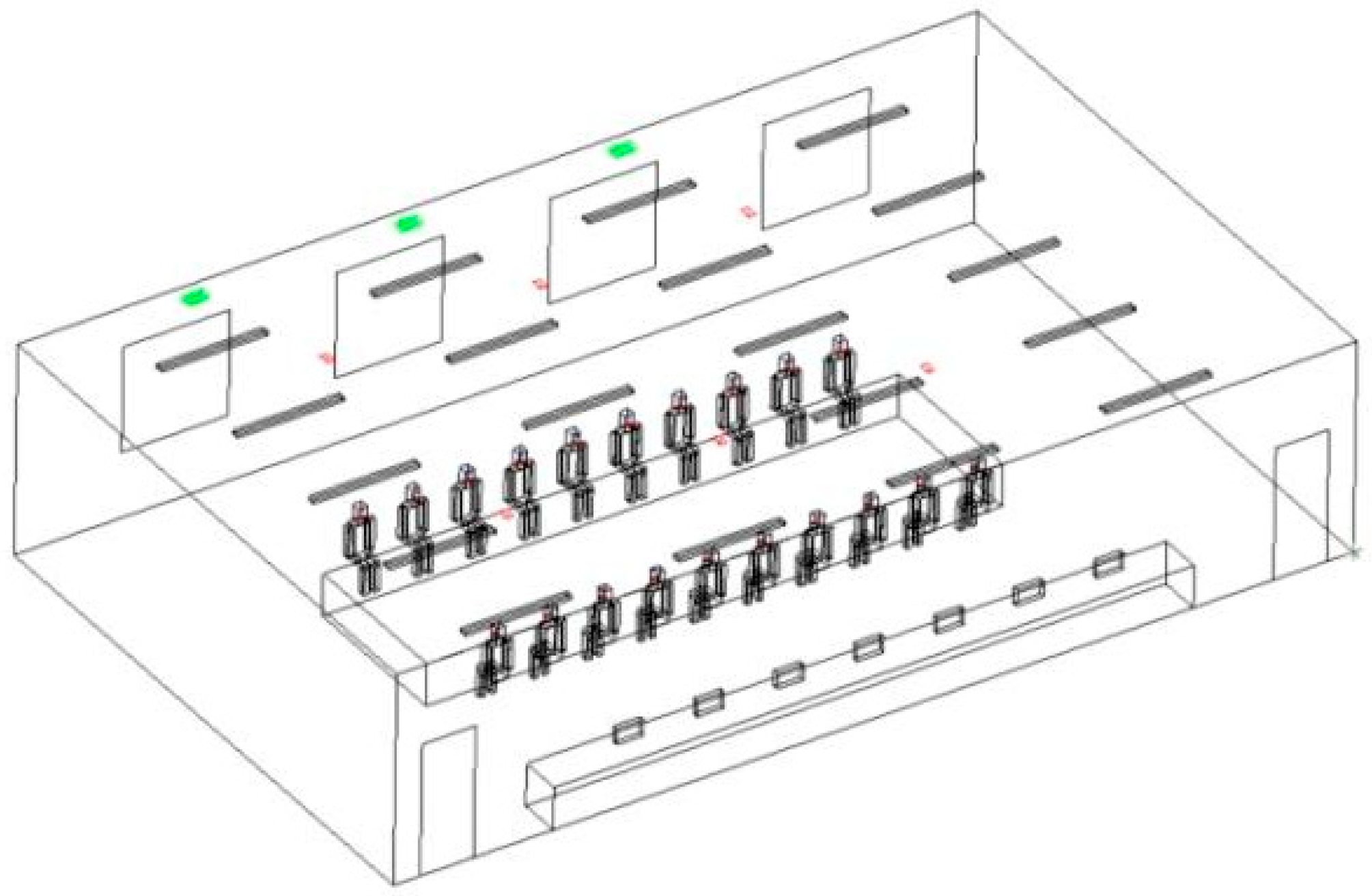
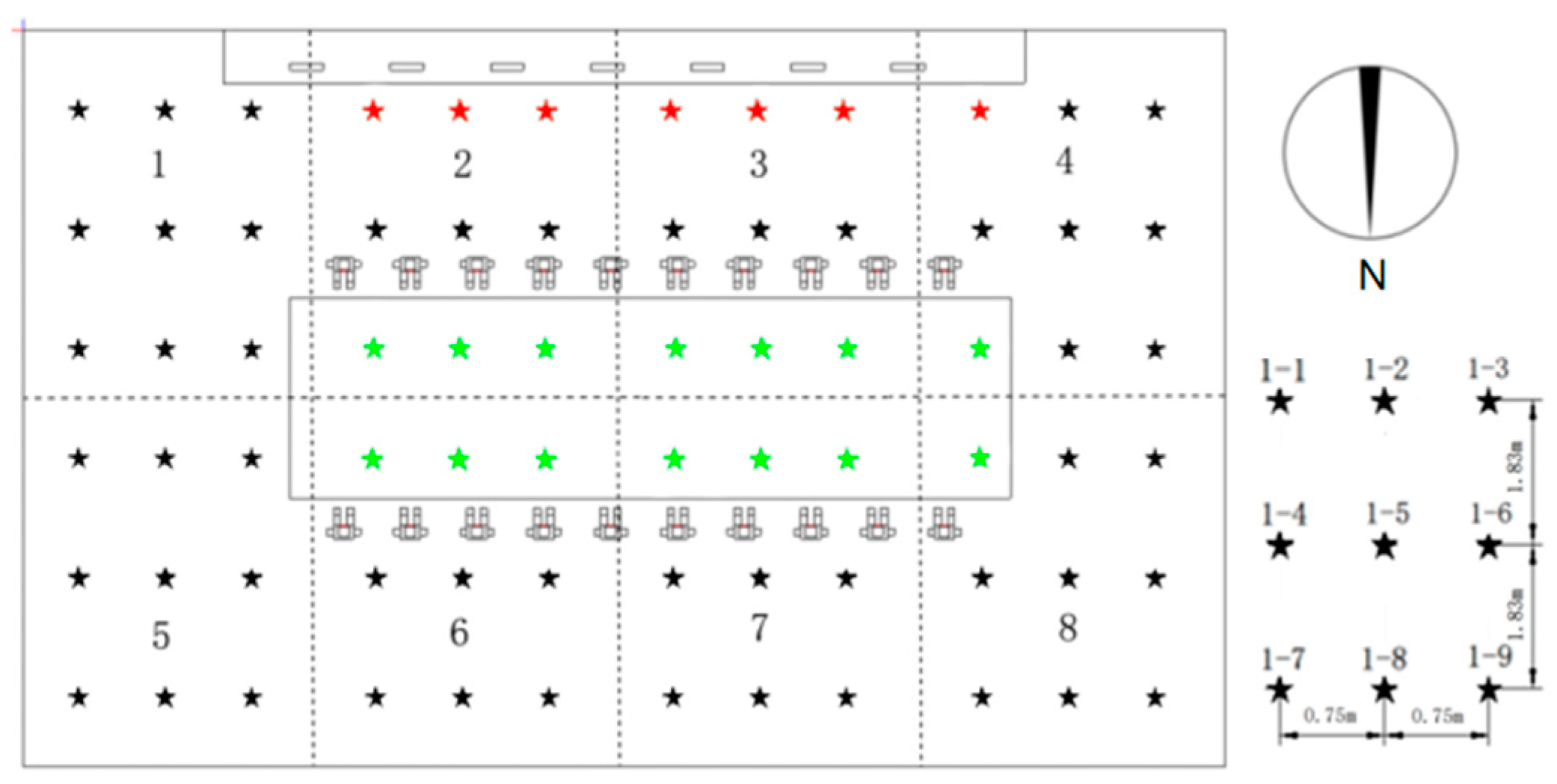
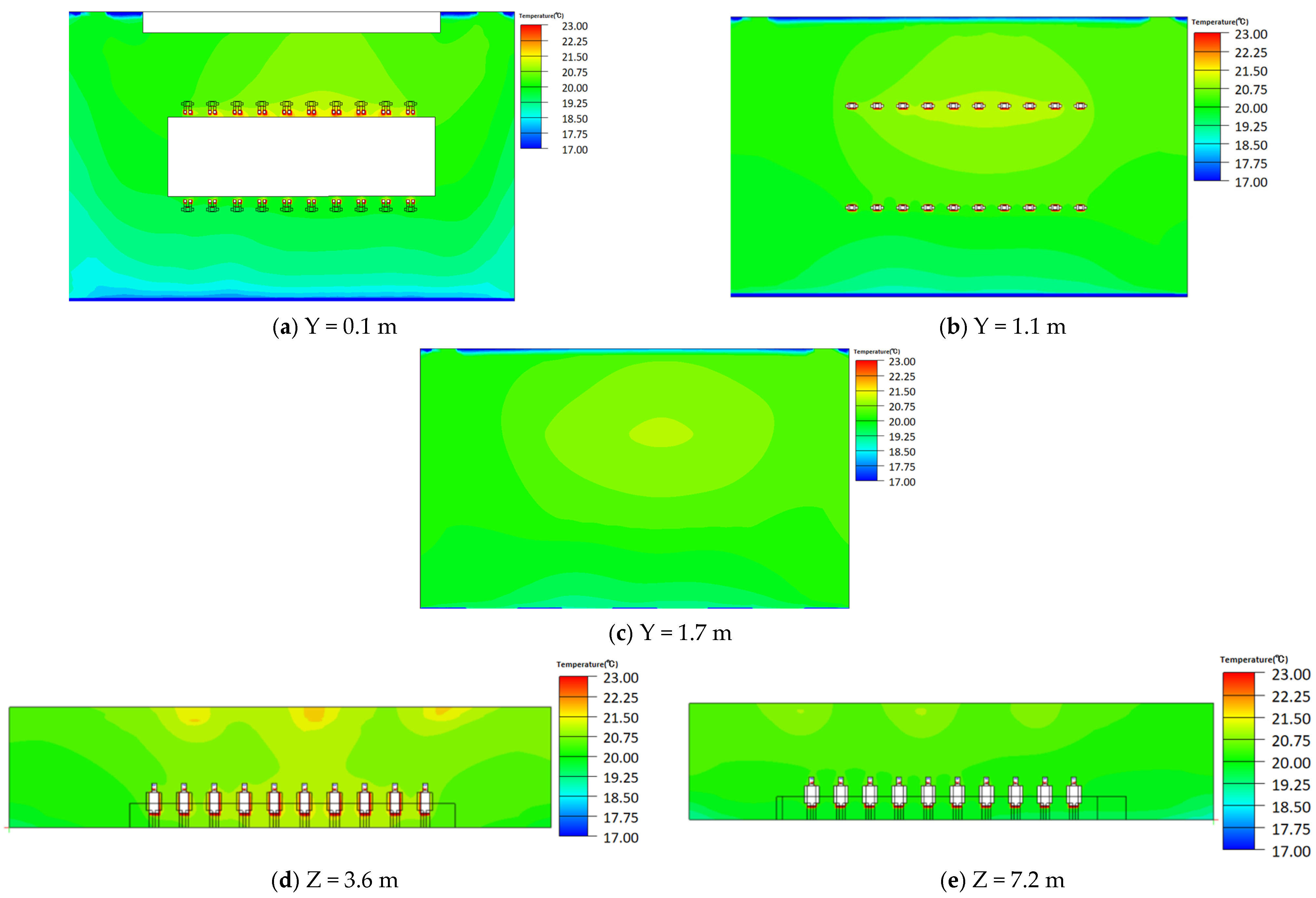


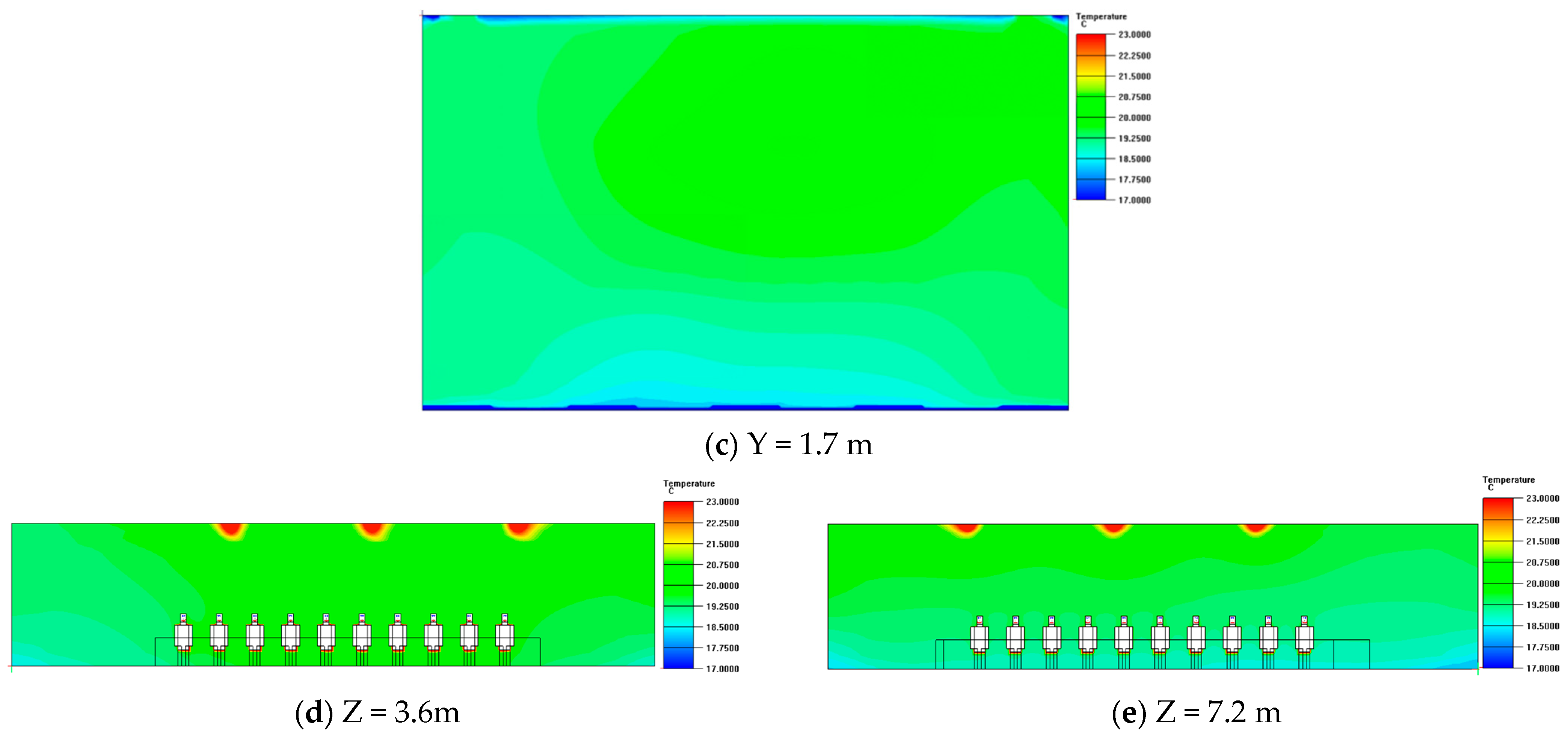

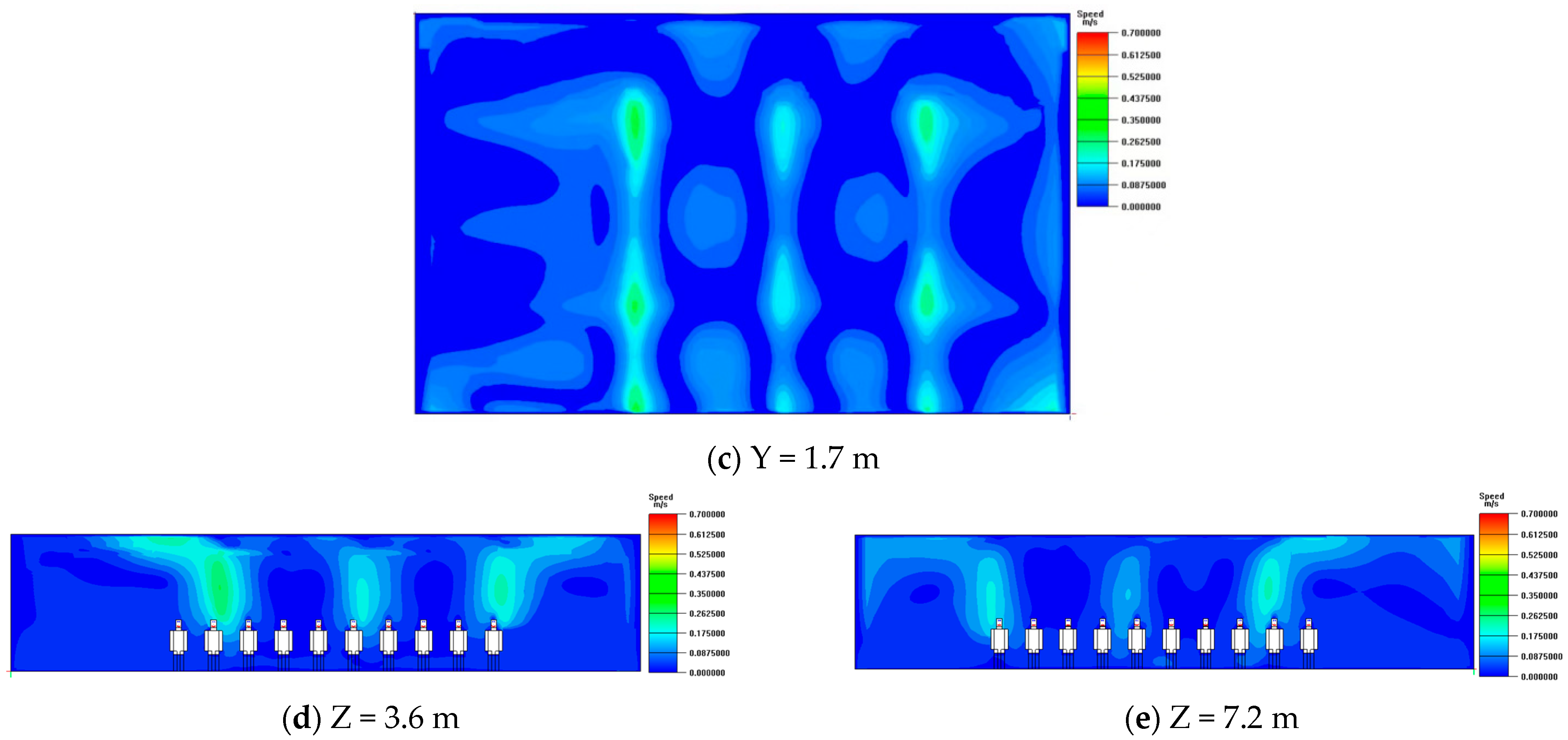
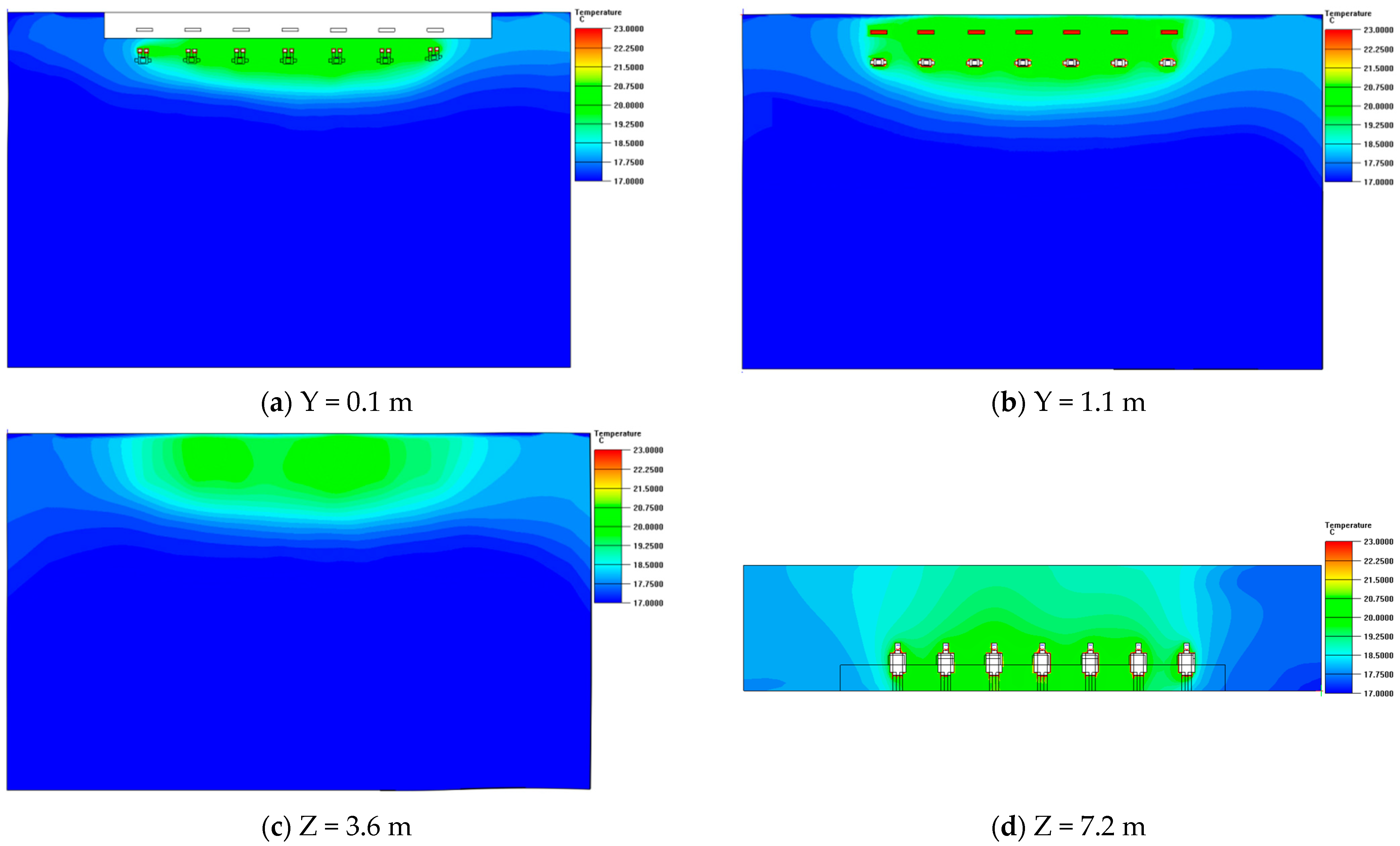
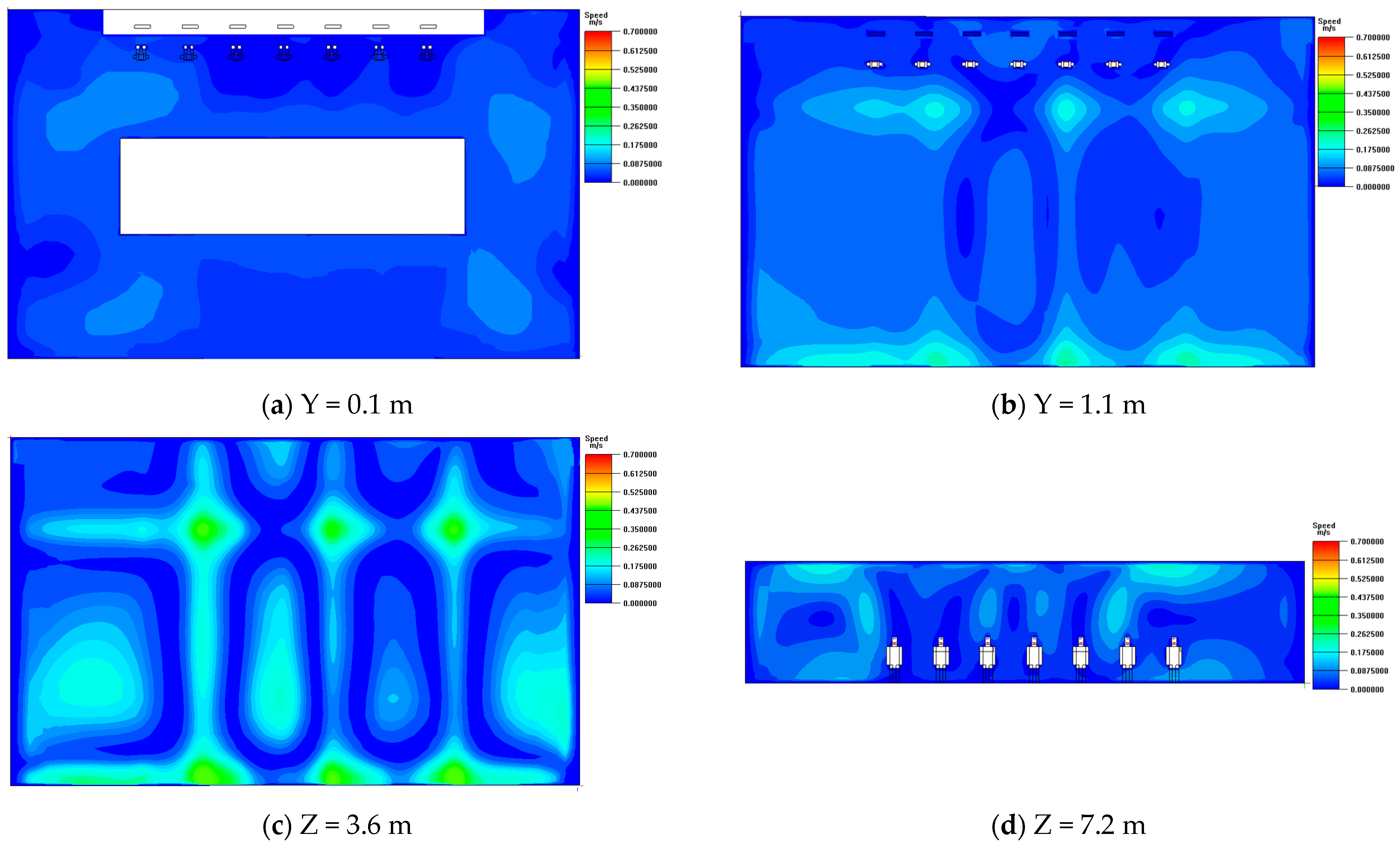

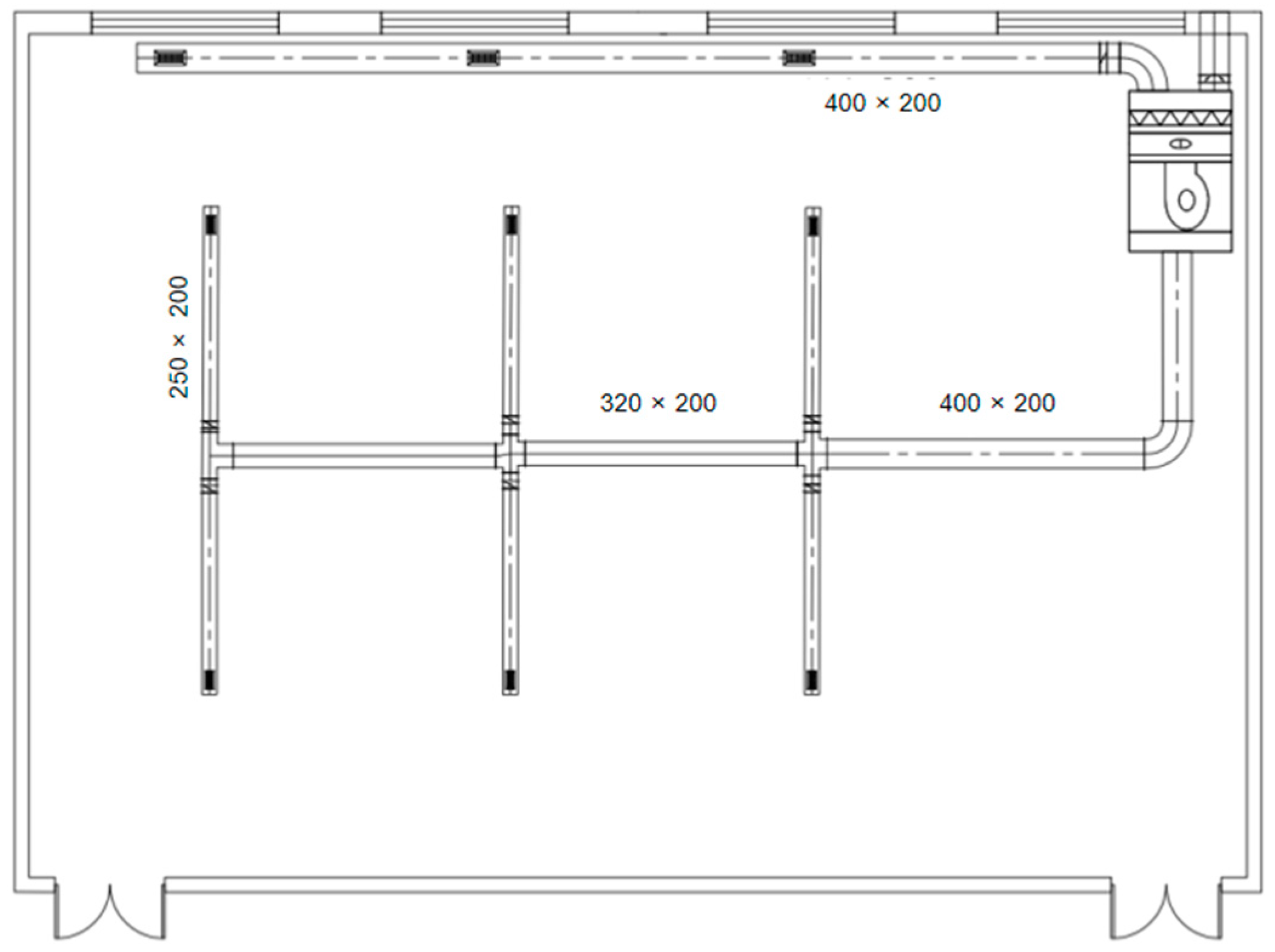
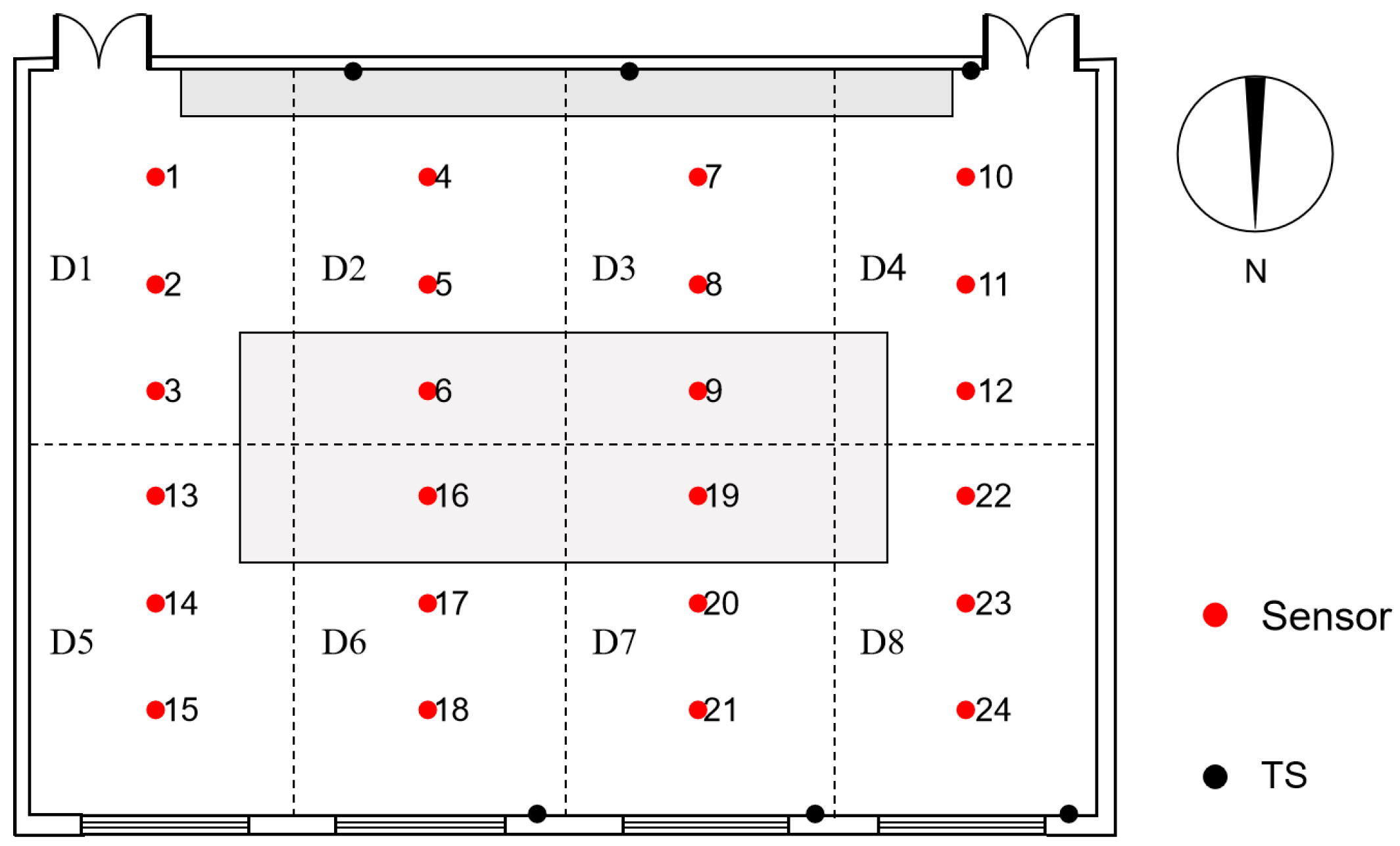
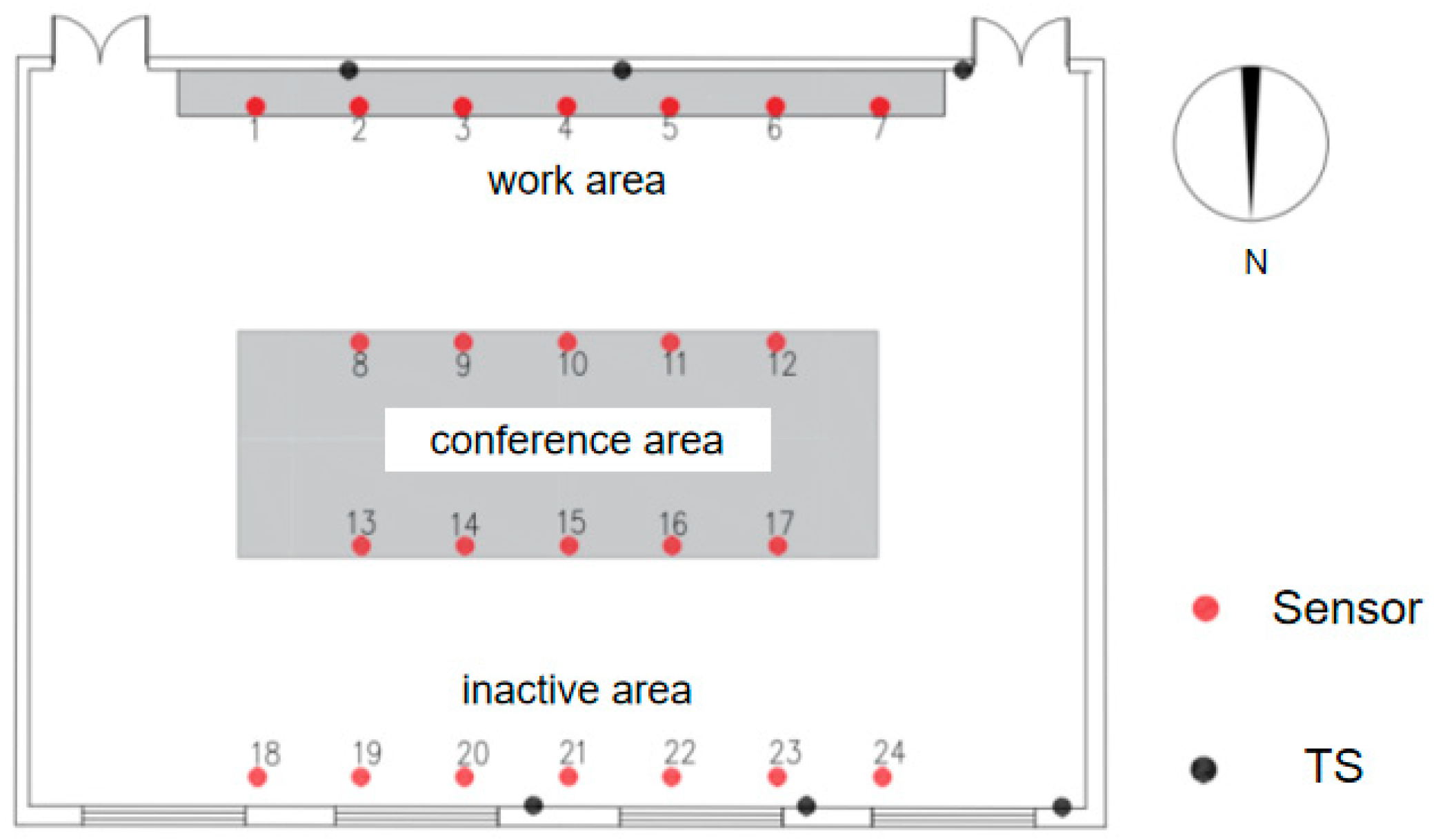
| Abbreviation | Full Name |
|---|---|
| VAV | Variable air volume |
| HVAC | Heating, ventilation, and air conditioning |
| PCSV | Personalized ceiling supply ventilation |
| SF | Seat fan |
| ACPV | Air Clothing Personalized Ventilation |
| PECS | Personal environmental comfort system |
| OPSIS | Order preference by similarity to ideal solution |
| CFD | Computational fluid dynamics |
| TSOCC | Thermal-sensation-and-occupancy-based cooperative control |
| RBF | Radial basis function |
| ADPI | Air Diffusion Performance Index |
| Air Conditioning Operation Mode Air | Temperature/°C | Air Volume /(m3/h) | Airflow Velocity /(m/s) | Diffusion Angle |
|---|---|---|---|---|
| Complete space | 32 | 1170 | 1.5 | 90° |
| Conference Area | 32 | 1014 | 1.3 | 45° |
| Working area | 32 | 663 | 1.7 | 45° |
| Area | 1 | 2 | 3 | 4 | 5 | 6 | 7 | 8 |
|---|---|---|---|---|---|---|---|---|
| ADPI | 100% | 100% | 88.9% | 100% | 100% | 100% | 100% | 100% |
| Coefficient of temperature non-uniformity | 0.114 | 0.197 | 0.188 | 0.149 | 0.066 | 0.074 | 0.065 | 0.035 |
| Coefficient of velocity non-uniformity | 0.031 | 0.066 | 0.043 | 0.05 | 0.029 | 0.052 | 0.021 | 0.019 |
| Area | 1 | 2 | 3 | 4 | 5 | 6 | 7 | 8 | Conference Area |
|---|---|---|---|---|---|---|---|---|---|
| ADPI | / | 100% | 100% | / | / | 33.3% | 33.3% | / | 100% |
| Coefficient of temperature non-uniformity | 0.127 | 0.254 | 0.117 | 0.318 | 0.444 | 0.726 | 0.726 | 0.479 | 0.361 |
| Coefficient of velocity non-uniformity | 0.022 | 0.027 | 0.014 | 0.018 | 0.009 | 0.023 | 0.018 | 0.016 | 0.015 |
| Area | 1 | 2 | 3 | 4 | 5 | 6 | 7 | 8 | Working Area |
|---|---|---|---|---|---|---|---|---|---|
| ADPI | / | 44.4% | 55.6% | / | / | / | / | / | 100% |
| Coefficient of temperature non-uniformity | 0.438 | 0.896 | 0.682 | 0.797 | 0.237 | 0.394 | 0.261 | 0.288 | 0.375 |
| Coefficient of velocity non-uniformity | 0.037 | 0.054 | 0.038 | 0.062 | 0.019 | 0.021 | 0.025 | 0.018 | 0.012 |
| Air Conditioning Operation Mode | Average Temperature/°C | Airflow Rate /(m/s) | Exhaust Air Temperature /°C | Temperature Non-Uniformity Coefficient | Velocity Non-Uniformity Coefficient | ADPI |
|---|---|---|---|---|---|---|
| Total space | 20.3 | 0.06 | 20.5 | 0.224 | 0.013 | 93.1% |
| Conference area | 18.7 | 0.07 | 18.8 | 0.389 | 0.016 | 40.7% |
| Working area | 15.5 | 0.06 | 12.6 | 0.702 | 0.012 | 12.5% |
| Air conditioning Operation Mode | Return Air Temperature/°C | Air Volume /(m3/h) | Air Velocity/(m/s) |
|---|---|---|---|
| Complete space | 20.7 | 1110 | 1.5 |
| Conference area | 19.2 | 1000 | 1.3 |
| working area | 15.1 | 635 | 1.7 |
| Instrument Name | Model | Accuracy | Measurement Parameter | Measurement Range | Manufacturer | Location |
|---|---|---|---|---|---|---|
| Temperature and humidity self-planning | TH11R | ±0.2 °C Resolution 0.1 °C | Temperature | −40–85 °C | Huahanwei Technology Co., Ltd. | Shenzhen, China |
| Hot-wire anemometer | KA23 | 0.00–4.99 m/s ± 2%FS 5.00–50.0 m/s ± 2%FS | Air velocity | 0.00–50.0 m/s | kANOMAX | Osaka, Japan |
| Volume hood | GTI610 | ±3% of the reading ± 10 m3/h (>85 m3/h) | Air volume | 40–4300 m3/h | Swema | Stockholm, Sweden |
| Station Position | 1 | 2 | 3 | 4 | 5 | 6 | 7 | 8 | 9 | 10 | 11 | 12 |
|---|---|---|---|---|---|---|---|---|---|---|---|---|
| Temperature/°C | 19.6 | 19.7 | 20.2 | 19.8 | 19.9 | 20.3 | 20 | 20.5 | 20.2 | 20.1 | 19.8 | 20.3 |
| Air velocity/(m/s) | 0.02 | 0.03 | 0.04 | 0.03 | 0.07 | 0.05 | 0.03 | 0.06 | 0.02 | 0.01 | 0.02 | 0.01 |
| Station position | 13 | 14 | 15 | 16 | 17 | 18 | 19 | 20 | 21 | 22 | 23 | 24 |
| Temperature/°C | 20 | 19.9 | 19.7 | 20.1 | 20.2 | 20.2 | 20.1 | 20.3 | 19.9 | 20.2 | 20.3 | 20.1 |
| Air velocity/(m/s) | 0.01 | 0.03 | 0.02 | 0.05 | 0.06 | 0.04 | 0.06 | 0.05 | 0.02 | 0.02 | 0.01 | 0.02 |
| Air Conditioning Operation Mode | Region | Average Temperature/°C | Average Air Velocity/(m/s) | Coefficient of Temperature Non-Uniformity | Coefficient of Velocity Non-Uniformity | ADPI |
|---|---|---|---|---|---|---|
| Total space | room | 20.1 | 0.03 | 0.23 | 0.018 | 91.7% |
| Conference area | Conference area | 20.1 | 0.06 | 0.46 | 0.067 | 100% |
| Working area | 19 | 0.03 | 0.28 | 0.024 | 28.5% | |
| room | 19 | 0.04 | 0.36 | 0.044 | 50% | |
| Working area | Conference area | 17.9 | 0.02 | 0.57 | 0.011 | / |
| Working area | 20.5 | 0.05 | 0.2 | 0.037 | 100% | |
| room | 17.7 | 0.03 | 0.41 | 0.022 | 29.2% |
Disclaimer/Publisher’s Note: The statements, opinions and data contained in all publications are solely those of the individual author(s) and contributor(s) and not of MDPI and/or the editor(s). MDPI and/or the editor(s) disclaim responsibility for any injury to people or property resulting from any ideas, methods, instructions or products referred to in the content. |
© 2024 by the authors. Licensee MDPI, Basel, Switzerland. This article is an open access article distributed under the terms and conditions of the Creative Commons Attribution (CC BY) license (https://creativecommons.org/licenses/by/4.0/).
Share and Cite
Chen, T.; Zhang, M.; Han, S.; Han, Y. Research on Regulation Method of Variable-Air-Volume Air Conditioning System with “Personal Space”. Energies 2024, 17, 5041. https://doi.org/10.3390/en17205041
Chen T, Zhang M, Han S, Han Y. Research on Regulation Method of Variable-Air-Volume Air Conditioning System with “Personal Space”. Energies. 2024; 17(20):5041. https://doi.org/10.3390/en17205041
Chicago/Turabian StyleChen, Tingting, Mingyuan Zhang, Shaoqing Han, and Yuhang Han. 2024. "Research on Regulation Method of Variable-Air-Volume Air Conditioning System with “Personal Space”" Energies 17, no. 20: 5041. https://doi.org/10.3390/en17205041
APA StyleChen, T., Zhang, M., Han, S., & Han, Y. (2024). Research on Regulation Method of Variable-Air-Volume Air Conditioning System with “Personal Space”. Energies, 17(20), 5041. https://doi.org/10.3390/en17205041





